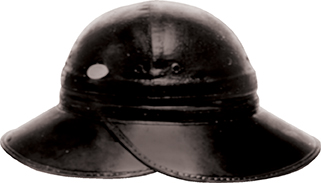The Interesting History Of Hard Hats
We all know hard hats as the important piece of protective gear you would see on construction site. Its history is rather interesting. The hard hat became widespread during one of the most industrious times in history. However, the very first iteration of this important piece of safety equipment was a bit of a funny hard hat.
The First Hard Hats
In the very early years of shipbuilding, workmen would take tar and cover their own hats with them then set the hates in the sun to harden. This was done as shipbuilders were in danger of being hit by falling objects of ship decks.

Since 1898 the E.D Bullard Company sold protective hats made of leather. They were a mining equipment company. Then when the owner’s son, E.W. Bullard returned from World War 1 he brought back with him a steel hat given to infantry and the idea to create better head protection for workers. In 1919 Bullard patented the “hard-boiled hat” which was constructed from steamed canvas, glue and black paint. During the same year, the Navy would commission him to create a shipyard protective hat which was the first real iteration of what we know as the hard hat. Soon after Bullard would design an internal suspension system for the hats which caused them to become far more effective in their protection.
Becoming Mainstream
The first major project to require hard hat use was the 1931 construction of the Hoover Dam. One of the largest construction projects in American history. Then in 1933 by order of Joseph Strauss, the construction of the golden gate bridge had mandated the use of hard hats as well as safety net installation to protect workers.
Strauss would go on to make a request of Bullard to design hard hats that would protect the workers during sandblasting. They would cover the workers face and have a clear shield form which they could see through and an air hose to allow fresh air while they worked. They were made of lighter material as well since during that time many hard hats were constructed of steel.
Strauss took great pride in creating a safe workplace which drove innovation for the signature piece of workplace protection. The hard hat had its presence certified by some of the most important moments of construction in American history and it’s ability to protect workers became a foundation of any construction project.
New & Better Designs
In 1938 the principle material of hard hats shifted from steel to aluminum. This excluded electrical work of course. Soon plastic became a popular material due to its nature to withstand radiant heat in the workplace. With the advent of electrical equipment being more widespread it was necessary to develop a hard hat that would not conduct electricity, remained protective and still lightweight enough to use.

Plastic was a breakthrough material, as it was easy to manufacture and it was extremely strong and lightweight compared to the heavy metals used in hard hats up to that point.
Many companies would enter the hard hat game creating variations for specific needs. Mining became important in this area and came with the introduction of many specific miners designed hard hats.
During the 1940s Fiberglass came into use, then in the 50’s Thermoplastics took over. This was because it’s shape was easier to mold with heat and cost less to manufacture.
In 1952, the shock-guard helmet was introduced which could protect workers from up to ten thousand volts of electricity. 1961 saw the introduction of the first polycarbonate hard hat and led to the creation of the V-Gard helmet in 1962 which has become the most widely used hard hat in the united states. Over the years more advancements would be made to the design, allowing for better ventilation and comfort, as well the use of accessories like face shields, sun visors, and even earmuffs.
Modern Hard Hats
In modern times most hard hats are made from advanced engineered resins, or more commonly high-density polyethylene. They have even greater quality of life improvements, like fabric that absorbs perspiration and maintains wearer comfort. Companies like MSA have nearly a century of experience with impact and heat hazards in industrial and fire environments and they strive to provide outstanding protection in hot and dangerous industries. One of the most popular Hard Hats today is the MSA Skullgard helmet which is tested to radiant heat loads producing temperatures up to 350-degrees Fahrenheit.
Hard Hat Accessories
Hard Hat Stickers have also become commonplace. They are used for a number of reasons. The more utilitarian is to notify first respondents of medical information, they also used to signify medical response teams and safety information. They are also used to denote workers who have shown safe work site behaviors so stickers are much more than just flair. Hard Hat Stickers have become a source of humor and levity for a long hard workday. The suspension liners have also improved greatly and come in many comfortable designs. They are adjustable, have cooling features and are replaceable.
The hard hat had silly origins and became a tradition before it was adopted as a mainline piece of construction equipment. Now, because of the push for safety made during the post-war boom of the United States hard hats have become a requirement on any construction site you see. They have gone through an interesting history and have taken many interesting forms. So now you have an idea of how much goes behind the saying of “safety first”.

